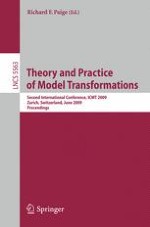Models have become essential for supporting the development, analysis and e- lution of large-scale and complex IT systems. Models allow di?erent views, p- spectives and elements of a system to be captured rigorously and precisely, thus allowing automated tools to manipulate and manage the models. In a full-?edged model-driven engineering (MDE) process, the transformations developed and - pressed between models are also key. Model transformations allow the de?nition and implementation of the operations on models, and also provide a chain that enables the automated development of a system from its corresponding m- els. Model transformations are already an integral part of any model-driven approach, and there are a number of available model transformation languages, tools, and supporting environments; some of these approaches are now approa- ing maturity. Nevertheless, much work remains: the research community and industry need to better understand the foundations and implications of model transformations, such as the key concepts and operators supporting transfor- tion languages, their semantics, and their structuring mechanisms and properties (e. g. , modularity, composability and parametrization). The e?ect of using model transformations on organizations and development processes – particularly when applied to ultra-large scale systems, or in distributed enterprises – is still not clear. These issues, and others related to the speci?cation, design, implemen- tion, analysis and experimentation with model transformation, are the focus of these proceedings. The Second International Conference on Model Transformation (ICMT 2009) was held in late June 2009 in Zurich, Switzerland.
